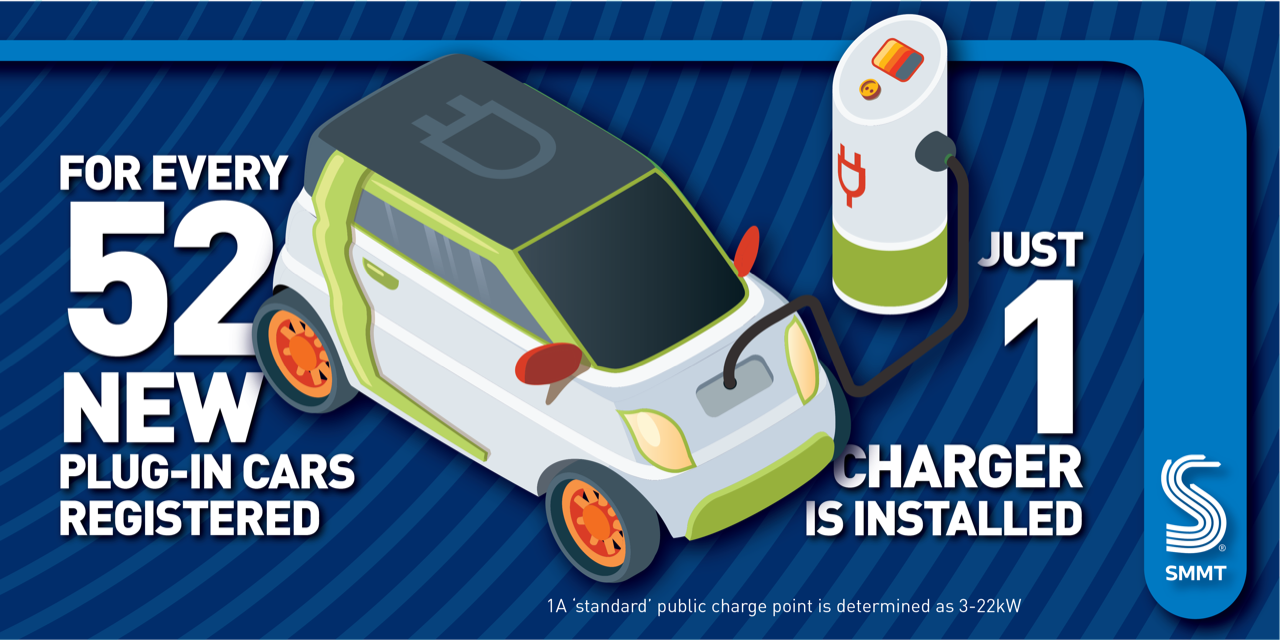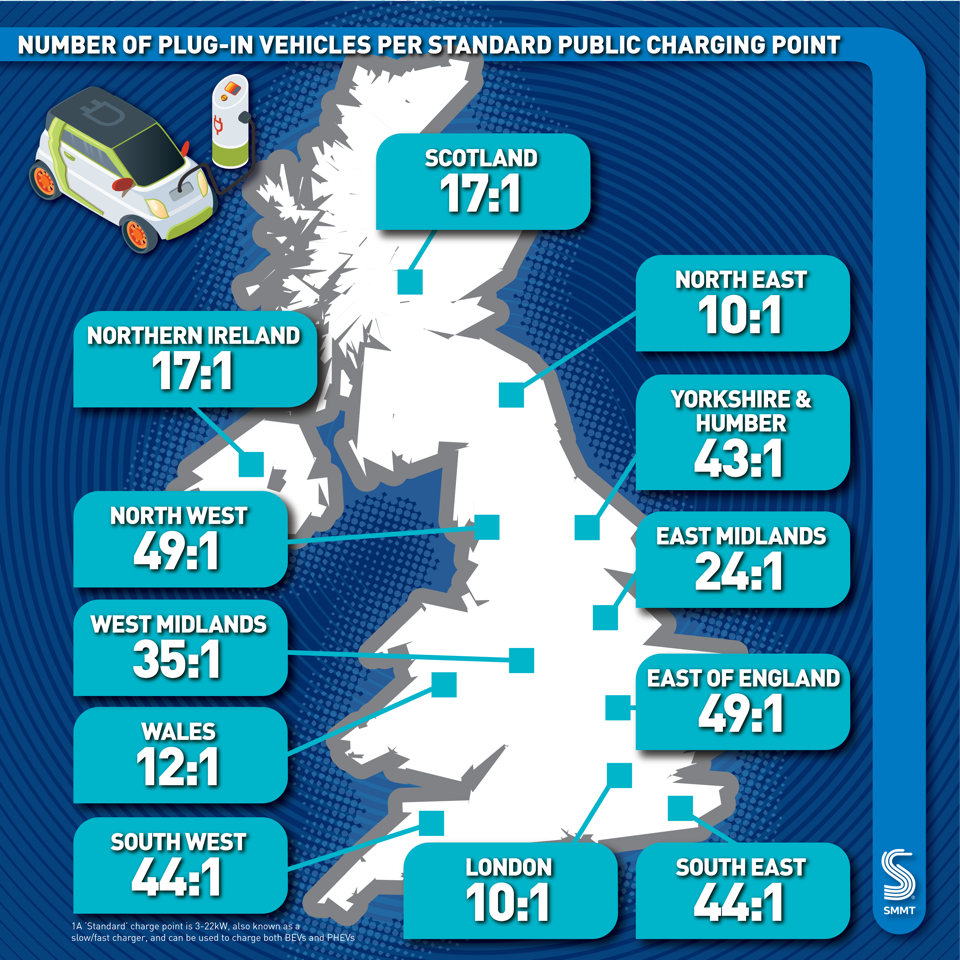- New SMMT analysis reveals that the number of battery electric and plug-in hybrid vehicles potentially sharing a standard public charge point deteriorated from 11 to 16 vehicles per charger between 2019 and 2020.1
- Only one new charger is currently being installed for every 52 new electric vehicles registered, with cars that can be plugged-in now accounting for one in every six new car registrations.
- SMMT calls for commensurate targets for charging infrastructure rollout to ensure all can have the confidence to make the switch to zero emission motoring.
New analysis by the Society of Motor Manufacturers and Traders (SMMT) has revealed that the ratio of vehicle chargepoints to plug-in cars deteriorated by -31% during 2020. The research shows that at the end of 2019, 11 plug-in vehicles potentially shared a standard public chargepoint capable of charging both battery electric (BEVs) and plug-in hybrid vehicles (PHEVs). In contrast, at the end of 2020, the ratio had fallen to one charger for every 16 plug-ins.
While most people currently purchasing an electric vehicle are likely to be able to plug in at home, on a driveway or designated parking bay, achieving net-zero requires all drivers to make the switch, including those who depend on on-street parking.
Plug-in vehicles continue to grow in popularity, accounting for around one in every six new cars registered in 2021.2 The public charging infrastructure required to keep them moving, however, must keep pace with the accelerating vehicle uptake, but the numbers reveal that public chargepoint rollout is lagging behind.
Britain’s ratio of plug-in vehicles on the road to standard public chargers has deteriorated to become one of the worst among the top 10 global electric vehicle markets at 16:1 in 2020. South Korea (3:1), the Netherlands (5:1), China (9:1), France (10:1), Belgium and Japan (both 13:1) all offer their EV drivers better coverage, although the UK does marginally outperform Germany (17:1).3
However, with 4,109 new standard public charge points installed between January and September 2021, compared with 212,181 new plug-in car registrations, just one new standard charger is being installed for every 52 new electric cars, a rate insufficient to improve the user experience.4
There are also significant regional disparities in the current provision of standard public charging points. London has the best ratio of cars to chargers at 10:1 – although this in itself fell from 5:1 in 2019. Meanwhile, the East of England has the lowest availability, with just one standard public charger for every 49 plug-in vehicles.
Meanwhile, Wales beats the national average with a ratio of 12:1, while Scotland weighs in at 17:1. If not addressed, these disparities will hamstring vast sections of the country in their ability to deliver zero emission motoring with all the air quality and carbon saving benefits this delivers, not to mention the benefits drivers can enjoy via lower EV running costs.5
Investments are being made in public charging with the Government’s Rapid Charging Fund allocating £950m to rapid and ultra-rapid chargepoints, £620m for zero-emission vehicle grants and infrastructure announced in the Net Zero Strategy, and a commitment that all new build homes will include an electric vehicle charging point.
This is insufficient, however, to keep up with consumer demand and targets for accelerated market transition, while increased new home charger provision will not provide any incentive for the millions of existing households that do not have a driveway or designated parking.
As a result, SMMT is calling on government to take regulatory action to boost public charge point provision, with binding targets for delivery, commensurate with the targets for vehicle manufacturers to deliver products, to ensure installation rates accelerate.
Mike Hawes, SMMT Chief Executive, said,
Appetite for electric vehicles has never been higher, but making Britain a net zero nation means convincing everyone, wherever they live, that an electric car can meet their needs. Those who can’t have their own home charge point need the confidence that they can still charge as conveniently as they can refuel. A deteriorating ratio of public charge points to cars will drain that confidence.
Recent Government funding for infrastructure was welcome but more private sector investment in public charge points is needed across the country. The UK therefore needs a framework of regulation that makes it easier to fund, build and operate electric vehicle charging infrastructure. Consequently we need commensurate and binding targets for charge point rollout and reliability so that all those without a driveway or designated parking can be confident of finding a convenient charger, and one that works.
Decarbonising road transport is essential if we are to address climate change but it needs a framework that compels all sectors to match the investment already being made by automotive to help consumers decarbonise their lives.
Notes to editors
1. A ‘standard’ public charge point is determined as 3-22kW, also known in the UK as a slow/fast charger, and can be used to charge both BEVs and PHEVs. These are normally found on streets, public car parks and destinations, such as supermarkets, retail parks and places of interest.
2. New BEV and PHEV registrations Jan-Sep 2021 – 212,181. Total new car registrations Jan-Sep 2021 – 1,316,614.
3. SMMT analysis of data from International Energy Agency (2021), Global EV Outlook 2021, available at https://www.iea.org/reports/global-ev-outlook-2021.
4. Source: https://www.gov.uk/government/statistics/electric-vehicle-charging-device-statistics-october-2021/electric-vehicle-charging-device-statistics-october-2021
5. SMMT analysis of data from Department for Transport (2021), Electric vehicle charging device statistics: July, available at https://www.gov.uk/government/statistics/electric-vehicle-charging-device-statistics-july-2021 and SMMT parc data.










